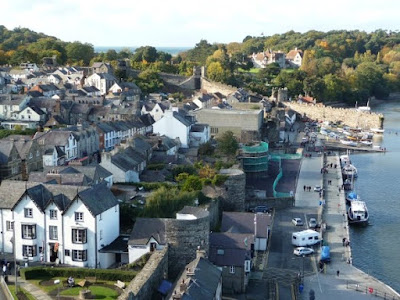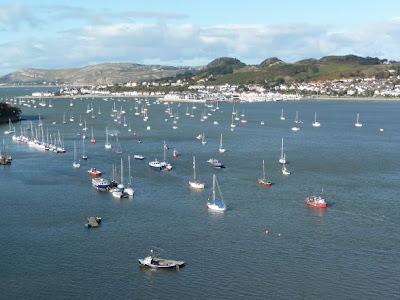The castle, most say, is the best of Edward's Welsh castles, relatively finished, big, an excellent example of concentric design with walled city, etc. In the past century, Caernarfon has been the site of the Royal Investiture, where the crown prince/princess becomes the Prince/Princess of Wales. When Charles was invested, 500 million people watched on TV. There is a nice exhibit on the Princes of Wales, the history of the position (started by Edward, whose son Edward II was born in the castle), the ceremony itself, in addition to the sizable castle exhibit and video.
G2G. The tide's rolling back in.
 |
Caernarfon Castle from the harbor; stolen, yes |
 |
View of the fortified harbor; not stolen |
 |
Interior view |
 |
View from tower |
 |
The Triple Eagle Tower, designed to impress the Welsh; note bands of stone, which Edward would have seen on his travels to Italy, the Holy Land, etc. |
 |
Charles' Investiture (from exhibit) |
 |
Last evening's sunset from our "campsite" on the Strait of Menai |
Vicki adds:
October 13, 2009 Caernarfon, Wales
We have camped the last two nights in a defunct area of an industrial estate as they call them here. Tonight we are actually in a free city lot, which is unusual in two ways. There is not a “no overnight parking” sign and it is free. It is right on the water—the straight that separates mainland Wales from Anglesy Island, the isle of the Druids. The bridge linking the two was built in 1826 by Robert Stephenson, undoubtably a cousin many times removed.
Rebecca and I visited Wales and the castle here in 2001 but this is Mark's first trip. It is also our third castle of Edward I in three days and we have probably now had enough. We have both an English Heritage pass and a National Trust pass. The two together allow us free entry to hundreds of sites. One caveat is that the Heritage pass gives only ½ price for Scotland and Wales unless you are a two year member. We have seen a great many things that we wouldn't have, had we not had the passes. We have also skipped a great many that we probably also would have enjoyed, but to do everything would take 5 months instead of the 3 we have. Mark originally thought 3 months too long but has since changed his mind. Perfect planning would have put us here from late April to late October. Next life.
October 13, 2009 Caernarfon, Wales
We have camped the last two nights in a defunct area of an industrial estate as they call them here. Tonight we are actually in a free city lot, which is unusual in two ways. There is not a “no overnight parking” sign and it is free. It is right on the water—the straight that separates mainland Wales from Anglesy Island, the isle of the Druids. The bridge linking the two was built in 1826 by Robert Stephenson, undoubtably a cousin many times removed.
Rebecca and I visited Wales and the castle here in 2001 but this is Mark's first trip. It is also our third castle of Edward I in three days and we have probably now had enough. We have both an English Heritage pass and a National Trust pass. The two together allow us free entry to hundreds of sites. One caveat is that the Heritage pass gives only ½ price for Scotland and Wales unless you are a two year member. We have seen a great many things that we wouldn't have, had we not had the passes. We have also skipped a great many that we probably also would have enjoyed, but to do everything would take 5 months instead of the 3 we have. Mark originally thought 3 months too long but has since changed his mind. Perfect planning would have put us here from late April to late October. Next life.














































